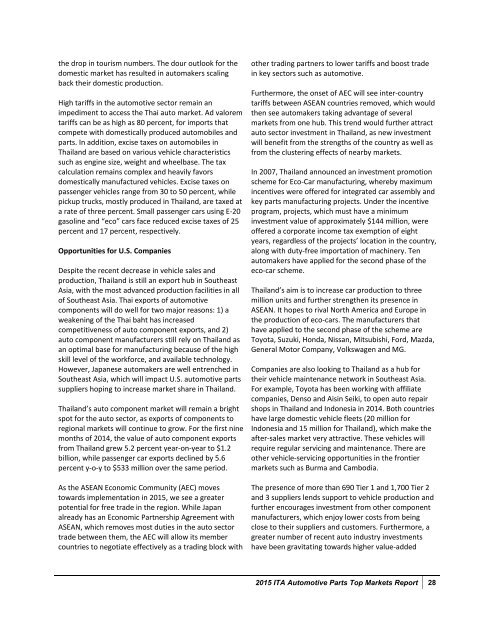Automotive Parts
Autoparts_Top_Markets_Report
Autoparts_Top_Markets_Report
You also want an ePaper? Increase the reach of your titles
YUMPU automatically turns print PDFs into web optimized ePapers that Google loves.
the drop in tourism numbers. The dour outlook for thedomestic market has resulted in automakers scalingback their domestic production.High tariffs in the automotive sector remain animpediment to access the Thai auto market. Ad valoremtariffs can be as high as 80 percent, for imports thatcompete with domestically produced automobiles andparts. In addition, excise taxes on automobiles inThailand are based on various vehicle characteristicssuch as engine size, weight and wheelbase. The taxcalculation remains complex and heavily favorsdomestically manufactured vehicles. Excise taxes onpassenger vehicles range from 30 to 50 percent, whilepickup trucks, mostly produced in Thailand, are taxed ata rate of three percent. Small passenger cars using E-20gasoline and “eco” cars face reduced excise taxes of 25percent and 17 percent, respectively.Opportunities for U.S. CompaniesDespite the recent decrease in vehicle sales andproduction, Thailand is still an export hub in SoutheastAsia, with the most advanced production facilities in allof Southeast Asia. Thai exports of automotivecomponents will do well for two major reasons: 1) aweakening of the Thai baht has increasedcompetitiveness of auto component exports, and 2)auto component manufacturers still rely on Thailand asan optimal base for manufacturing because of the highskill level of the workforce, and available technology.However, Japanese automakers are well entrenched inSoutheast Asia, which will impact U.S. automotive partssuppliers hoping to increase market share in Thailand.Thailand’s auto component market will remain a brightspot for the auto sector, as exports of components toregional markets will continue to grow. For the first ninemonths of 2014, the value of auto component exportsfrom Thailand grew 5.2 percent year-on-year to $1.2billion, while passenger car exports declined by 5.6percent y-o-y to $533 million over the same period.As the ASEAN Economic Community (AEC) movestowards implementation in 2015, we see a greaterpotential for free trade in the region. While Japanalready has an Economic Partnership Agreement withASEAN, which removes most duties in the auto sectortrade between them, the AEC will allow its membercountries to negotiate effectively as a trading block withother trading partners to lower tariffs and boost tradein key sectors such as automotive.Furthermore, the onset of AEC will see inter-countrytariffs between ASEAN countries removed, which wouldthen see automakers taking advantage of severalmarkets from one hub. This trend would further attractauto sector investment in Thailand, as new investmentwill benefit from the strengths of the country as well asfrom the clustering effects of nearby markets.In 2007, Thailand announced an investment promotionscheme for Eco-Car manufacturing, whereby maximumincentives were offered for integrated car assembly andkey parts manufacturing projects. Under the incentiveprogram, projects, which must have a minimuminvestment value of approximately $144 million, wereoffered a corporate income tax exemption of eightyears, regardless of the projects’ location in the country,along with duty-free importation of machinery. Tenautomakers have applied for the second phase of theeco-car scheme.Thailand’s aim is to increase car production to threemillion units and further strengthen its presence inASEAN. It hopes to rival North America and Europe inthe production of eco-cars. The manufacturers thathave applied to the second phase of the scheme areToyota, Suzuki, Honda, Nissan, Mitsubishi, Ford, Mazda,General Motor Company, Volkswagen and MG.Companies are also looking to Thailand as a hub fortheir vehicle maintenance network in Southeast Asia.For example, Toyota has been working with affiliatecompanies, Denso and Aisin Seiki, to open auto repairshops in Thailand and Indonesia in 2014. Both countrieshave large domestic vehicle fleets (20 million forIndonesia and 15 million for Thailand), which make theafter-sales market very attractive. These vehicles willrequire regular servicing and maintenance. There areother vehicle-servicing opportunities in the frontiermarkets such as Burma and Cambodia.The presence of more than 690 Tier 1 and 1,700 Tier 2and 3 suppliers lends support to vehicle production andfurther encourages investment from other componentmanufacturers, which enjoy lower costs from beingclose to their suppliers and customers. Furthermore, agreater number of recent auto industry investmentshave been gravitating towards higher value-added2015 ITA <strong>Automotive</strong> <strong>Parts</strong> Top Markets Report 28


